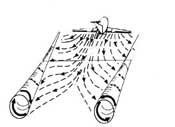Introduction
The Boeing jet in the picture at right has winglets at the tips of its wings. Why are they there? What do they do?
As an airplane moves through the air, the wings generate lift by creating an area of low pressure above the upper surface of the wing. The higher air pressure beneath the lower surface of the wing lifts the plane. At the tip of the wing, the high and low pressure air meet.

Figure 1. The diagram shows the expanding wing tip vortices generated by a passenger jet. (NASAexplores.com, date unknown)
The air forms miniature tornadoes, called wing tip vortices that spread out behind the plane (see Figure 1, right). Wing tip vortices cause two problems:
- the turbulent airflow they create can be strong enough to flip an airplane that encounters it;
- they also increase the drag forces on the airplane that generates them, decreasing fuel efficiency.
The airflow around winglets is complex. Your wind tunnel should include smoke or fog in the airflow so that you can visualize streamlines along the length of the airfoil. Figure 2, illustrates some design considerations you may wish to consider for the winglets (Hepperle, 2006). A gradual curve transistioning from airfoil to winglet may help to reduce turbulent flow at the corner region. Translating the winglet toward the trailing edge of the airflow can also promote laminar flow at the trailing edge of the wingtip.

Figure 2. Three different winglet designs. From left to right: no winglet, rounded corner, sharp corner, winglet translated toward trailing edge. (Hepperle, 2006)
In this project, you will test airfoils built both with and without winglets in a wind tunnel. Do you see evidence for wing tip vortices when testing airfoils without winglets? Does the addition of winglets alleviate wing tip vortices? Do the winglets increase lift? For winglet-related project ideas that do not require a wind tunnel, see the Variations section.
Terms and Concepts
To do this project, you should do research that enables you to understand the following terms and concepts:
- airfoil,
- chord line,
- mean camber line,
- camber,
- aspect ratio,
- angle of attack,
- winglets,
- drag,
- lift,
- wing tip vortices.
Questions
- What are the forces acting on an airfoil in a wind tunnel?
- How will the addition of winglets affect these forces?
- How will the addition of winglets affect flight performance?
Bibliography
- You'll definitely want to check out NASA's Beginner's Guide to Aeronautics. This site is packed with useful information on the science of flight. The "Guided Tours" make it easy to navigate through groups of related pages:
NASA, 2005a. "Guided Tours of the Beginner's Guide to Aeronautics," NASA, Glenn Research Center [accessed June 8, 2006 ]http://www.grc.nasa.gov/WWW/K-12/airplane/guided.htm.
Materials and Equipment
To do this experiment you will need the following materials and equipment:
- materials for building model airfoils, e.g.:
- balsa wood for framework,
- tissue paper covering,
- modeling knife,
- glue,
- airplane dope.
- (Alternatively, airfoil sections can be shaped from solid pieces of balsa or other wood.)
- wind tunnel for testing airfoils
Experimental Procedure
- Do your background research so that you are knowledgeable about the terms, concepts, and questions above.
- Construct two or more airfoils, identical in shape except for the presence/absence of winglets. See Figure 2 in the Introduction for ideas on different winglet designs you might wish to consider.
- Test your airfoils in a wind tunnel. The measurements that you are able to make will depend on the instrumentation available. Desirable measurements are:
- lift,
- drag,
- visualization of streamlines at the wing tip (using smoke or fog).
No comments:
Post a Comment